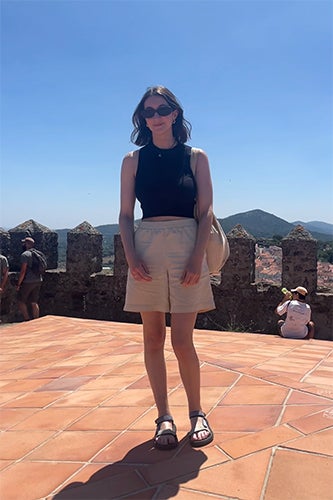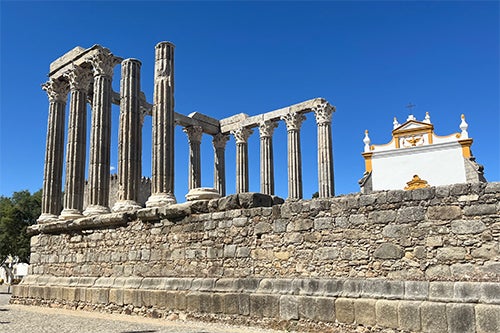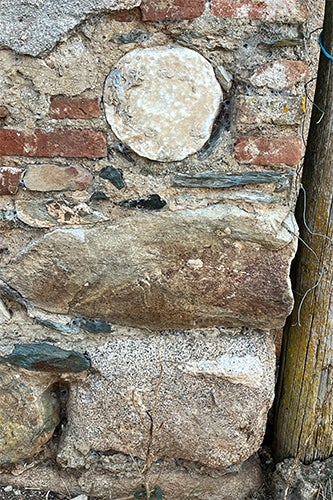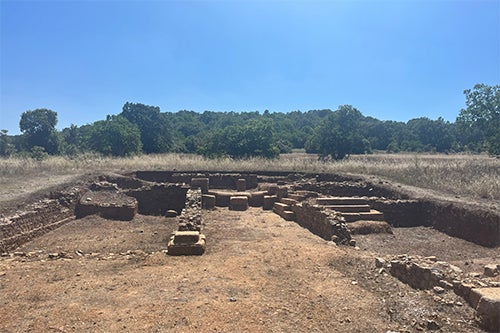Tallulah Trezevant is a senior in classics, where she is pursuing a Latin and Ancient Greek concentration with a minor in medieval studies. She also serves as president of both the UIUC Classics Club and Alpha Kappa chapter of Eta Sigma Phi.

During my freshman year fall semester, I attended a talk hosted by the Classics Club, an ancient history RSO on campus, featuring Dr. Betsy Bevis, a lecturer in the Department of Classics. In her talk, Dr. Bevis described her studies of Roman provincial life and how she primarily conducts her research, not from her office within the Literatures, Cultures & Linguistics Building, but on an archaeological excavation site located in a remote part of eastern Portugal. At the end of the talk, Dr. Bevis explained that any interested students can apply to take part in the excavation, on location, as part of the archaeological project’s field school. Without any idea of what an archaeological dig would actually be like, save the contents of Dr. Bevis’ lecture, I decided to apply.
An archaeological field school is a unique educational opportunity where students can learn how to participate in an archaeological excavation on-site. Essentially, it is an opportunity to learn by doing. In the summers of 2022 and 2023, I traveled to Redondo, Portugal to take part in the Santa Susana Archaeological Project Field School. The Santa Susana site is unique in that it was once home to an expansive latifundium, the Latin word describing a large agricultural villa, upon which a Medieval cathedral was constructed that is still in use to this day. The goal of the Santa Susana Archaeological Project excavation is to understand the functions of the villa in its Roman period, approximately the first century BCE until the fifth century CE, then its afterlife as a Christian site. In fact, the cathedral itself was built from the granite blocks used to construct the Roman villa and its roof is made from tegulae– Roman roof tiles.

At the field school, I learned how to map out the different layers of the excavation pits and dig within them. I found a variety of artifacts including pieces of pottery, glass shards, mosaic tiles called tesserae, ancient coins, and, my favorite, fragments of fresco paintings. Frescoes were extremely popular decorations in wealthy Roman homes created by painting on semi-dry plaster. Outside the excavation pit, I cleaned and organized the artifacts. Categorizing them in terms of artifact type and the exact location of discovery allowed me to create a comprehensive overview of the site and its contents. Specifically, this comprehensive overview allowed us to understand what kind of spaces existed in the villa and what they were used for based on where we found artifacts and the specific types of artifacts found in each space.

Another way to understand the context of a site is to conduct geophysical scans with ground-penetrating radar (GPR). GPR sends waves into the earth to locate if there are any subterranean structures, producing these scans can reveal entire structures not visible on the earth’s surface. Working with Portuguese geophysicists visiting the Santa Susana site, I had the opportunity to make scans with GPR, revealing that the foundations of the Roman villa extended far past where we were currently excavating. GPR is useful because it shows archaeologists where to excavate. Similarly, before GPR scans are even considered, archaeologists can identify a potential archaeological site by doing something called survey. To conduct survey, archaeologists walk around a potential site, observing the ground, looking out for evidence of artifacts visible on the surface such as pieces of building material, masonry, slag, marble, or pottery. Sometimes, in man-made structures, there is also the presence of spolia which is the recycling of building materials from old buildings reused in new buildings. While conducting survey at the ruins of a Medieval church a few miles from the Santa Susana site, I observed spolia, indicating the possibility that either the builders of the church used materials from Santa Susana or there is another, un-excavated, Roman villa nearby.

Finally, my field school led trips to historic locations around the Portuguese Alentejo region to
fully understand what life in Roman Iberia was like. My personal favorite places we visited were
the Roman temple dedicated to Emperor Augustus in Evora, Portugal and the Roman city of
Ammaia in Marvão, Portugal.